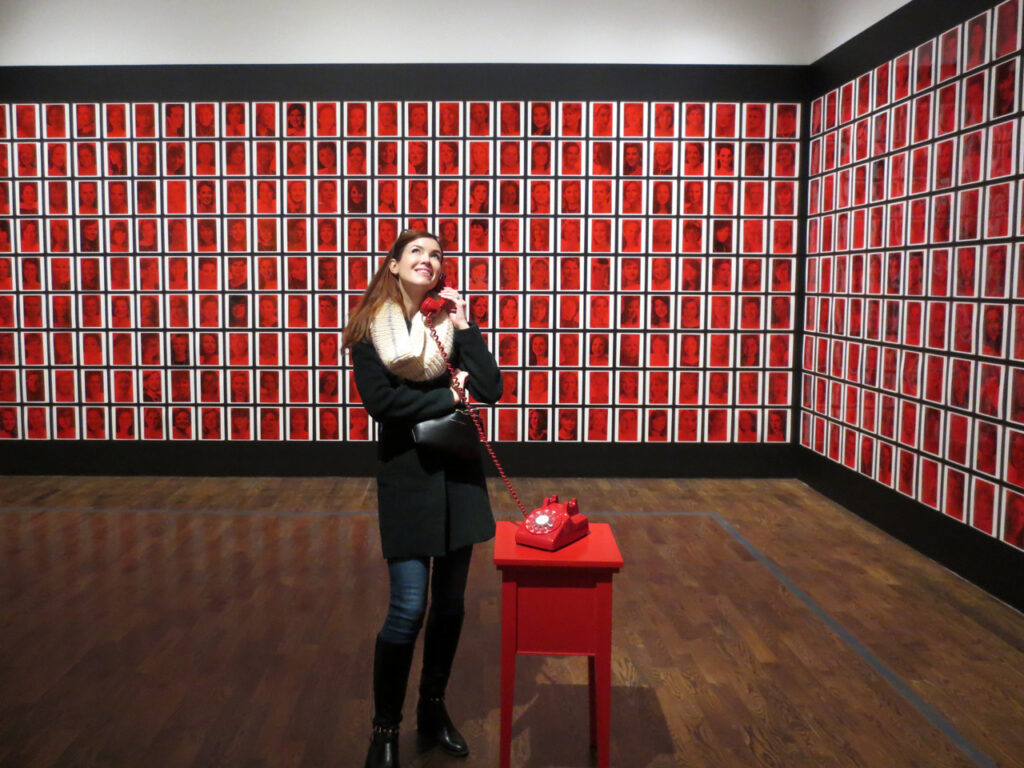Hello! My friend Leslie and I spent a lovely afternoon together recently, checking out a museum and getting some ice cream.
The museum was the The Textile Museum of Canada, where two temporary exhibitions are currently on display.
I wouldn’t say it is common knowledge that the country’s official Textile Museum is right here in downtown Toronto, one street east of the corner of Dundas and University Avenue. I first heard about it a while back from my friend Julie, who highly recommended it, so it’s been on my list of places to visit. Then, while at the library, I saw that passes for the museum were available, thanks to Sunlife Financial and their generous supporting of the “Museum and Arts Pass” program, where anyone in the city with a Toronto library card can get passes to a variety of museums and galleries, on a first-come-first-served basis, with new passes distributed every Saturday morning. So, I picked one up.
When I later looked at the Textile Museum’s site and saw that an amazing sounding show was on, Color Improvisations 2: An International Exhibition of Contemporary Quilts, I knew exactly who I’d ask to come along and see it. Leslie’s favourite artistic pastime, (aside from baking, and if you’ve been reading along, you’ll already know that her creations are wonderful and delicious works of art), is colouring. She loves her big box of pencil crayons and adult colouring books. So, when I saw images of some of the quilts that were in this show, I knew the colourful pieces would appeal to her.
The exhibition was curated by fiber artist Nancy Crow. Each of the 25 large-scale pieces, created by quilters from all over the world, was made specifically for this touring exhibition. Each of the artists involved has, at one point, studied with Nancy Crow.
I’ve tried to include photographs that will give you a sense of the size of these pieces. These are not quilts intended to be used on beds, but are rather, abstract artworks using cotton as their medium.
I’ve also tried to include some close ups so you can see how challenging creating one of these quilts would be. There are no printed fabrics used, so the patterns and designs were all achieved by cutting and sewing different colours of cotton together. The skill involved is impressive, indeed.

↑ A quilt and quote by the curator of the show, Nancy Crow. ↑
The exhibit runs until September 23rd. We both loved it and think you will too, if you enjoy abstract, colours and fabric.
While we were at the gallery, we dropped in to see their second exhibition, currently on until March 31, 2019, Crosscurrents: Canada in the Making, which was also excellent.
The display “explores ongoing cultural exchanges and interactions between Indigenous people, settler Canadians and newcomers over the last two centuries, and examines shifting identities, intersections and contestations that inform textile expressions alongside the stories of those who make Canada their home.”

↑ The examples of handmade children’s clothing were from the mid 1800s to late 1900s. Since every scrap of fabric was used to its fullest, it is quite rare that these survived, as most things would have been repurposed again to make quilts and rugs, and then finally used as rags. ↑

↑ I was intrigued by the Sailor Suit, as the note clearly states it was a boy’s outfit. In my various historic travels back in time via the internet, I’ve seen many examples of boys and girls wearing sailor inspired clothes, from here, the UK and Germany. The style was very common, almost the norm, for children’s ware, for a good 50 years beginning in the early 1900s, supposedly after Queen Victoria dressed her children in the style. But, of course, the curious thing about this particular outfit is the skirt for a boy who, based on the size, would have been about 5. I tried hard to find out why the skirt, and came up almost empty, as, while baby boys often wore dresses back then, young boys normally wore short pants and older boys wore long pants.

↑ Here’s the single example of a sailor suit with a skirt, worn by a boy. I couldn’t find the original source, location or date for it though. ↑
↑ Some young boys wearing the style here in Toronto, at the CNE in 1929. Note the tights worn with the shorts. ↑
↑ A hooked rug from the mid 1900s. This type or rug making was first used by Canadian settlers, after they began weaving burlap, which is used as the base for the rugs. A hook was used to pull lengths of cut rags up through the weave of the burlap. ↑
↑ Woven coverlets, one with the date 1847 incorporated right in. ↑
The Textile Museum is a very interesting place. It’s easy to get to and just the right size to see in an hour or two. And since it’s located near Chinatown, Kensington Market, Queen West and Nathan Phillips Square, you can pop into while exploring other parts of the city.
Speaking of which, after we left the museum, Leslie pulled up a list that she has predominantly bookmarked on her phone — this one compiled by Toronto Life Magazine, of the city’s “creamiest, dreamiest, most over-the-top soft serve ice-cream sensations this summer (my pal has a notorious sweet tooth, and plans to visit each place on the list!) — to see if we happened to be nearby one of the ice-cream parlours. We were in luck, as the museum is located near Dundas and University Avenue, and one of her targets, Cutie Pie Cupcakes, was a short walk away in Chinatown, on Spadina Avenue, just south of Dundas.
Then, fueled by a sugar rush, we walked around the Queen West neighbourhood …
↑ A community garden on Richmond Street. ↑
Thanks very much for reading. I hope you have a great weekend!
xo loulou




























